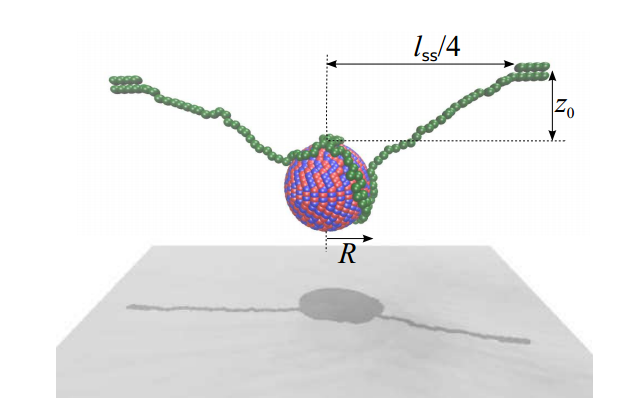How To Build an Intelligent Blob That Shrinks When it Detects Viruses
Here’s an interesting idea. The threat from viral pathogens such as bird flu, hepatitis B and HIV, represents a clear and present danger. So cheap and simple tools for detecting these viruses are much needed, particularly in the developing world where the threat is acute but money scarce.

Step forward Jaeoh Shin and pals at the University of Potsdam in Germany who say that it is possible to create just such a virus detector using little more than a few strands of DNA mixed into a lump of hydrogel. This ‘intelligent’ blob would shrink when the virus in question was around giving a clear visible signal that precautions need to be taken.
Here’s their thinking. Biologists have long known that viruses bind to sections of DNA and this causes the double helix to unwind into two single strands, or ‘melt’ as biologist call it. The single strands can then become adsorbed into the surface of the virus and this shortens their total length. In fact, biologists have shown that melting-induced contraction can reduce the length of the strand by up to 90 percent.
So Shin and co’s idea is to stretch out the DNA strands in parallel, embed them in hydrogel and then wait. When virus particles turn up, they bond with the DNA, causing it to melt and contract and causing the hydrogel to shrink as well. “Viral particles in the hydrogel-DNA system…elect a macroscopic contraction of the hydrogel matrix,” they say.
To test the idea, these guys created a molecular simulation of the way a virus bonds to DNA and the consequent melting and contraction. The results certainly seem promising. “Viral particles in the hydrogel-DNA system destabilize [double strand] DNA and effect a macroscopic contraction,” they say.
One important question is how virus-specific the DNA can be made so that it responds only to HIV or avian flu or to some other specific virus. Shin and co say that the viruses bond preferentially to binding proteins and these can be linked to DNA. So with some simple biochemical fiddling, they should be able to make DNA that bonds only to specific viruses.
That certainly sounds possible but these guys need to be sure that the contraction signal is triggered uniquely by the target virus and nothing else. In other words, the false positive rate will have to be carefully studied and controlled. It’s an interesting idea that deserves more, careful study.
It also has some significant competition. There is no shortage of ideas for detecting viruses. The big advantage of this one is that it would be cheap enough to distribute widely, even in the developing world.
And therein lies the next challenge. Having developed the theory behind these detectors and simulated their behavior, Shin and co need to build one to show that it works. And not just in the lab but in all the extreme conditions of heat, humidity and dirt that doctors all over the world regularly face.
There’s no question that it ought to be possible to embed strands of DNA in hydrogel to make intelligent blobs that are cheap and simple. But until Shin and prove that the blobs work as they expect, this will remain merely a good idea rather than the potentially life-changing product that these guys clearly imagine it could be.
They’ve got significant work ahead. We’ll be watching to see how they fare.
Ref: arxiv.org/abs/1310.5531: Sensing Viruses By Mechanical Tension of DNA in Responsive Hydrogels
Keep Reading
Most Popular
Large language models can do jaw-dropping things. But nobody knows exactly why.
And that's a problem. Figuring it out is one of the biggest scientific puzzles of our time and a crucial step towards controlling more powerful future models.
The problem with plug-in hybrids? Their drivers.
Plug-in hybrids are often sold as a transition to EVs, but new data from Europe shows we’re still underestimating the emissions they produce.
How scientists traced a mysterious covid case back to six toilets
When wastewater surveillance turns into a hunt for a single infected individual, the ethics get tricky.
Google DeepMind’s new generative model makes Super Mario–like games from scratch
Genie learns how to control games by watching hours and hours of video. It could help train next-gen robots too.
Stay connected
Get the latest updates from
MIT Technology Review
Discover special offers, top stories, upcoming events, and more.